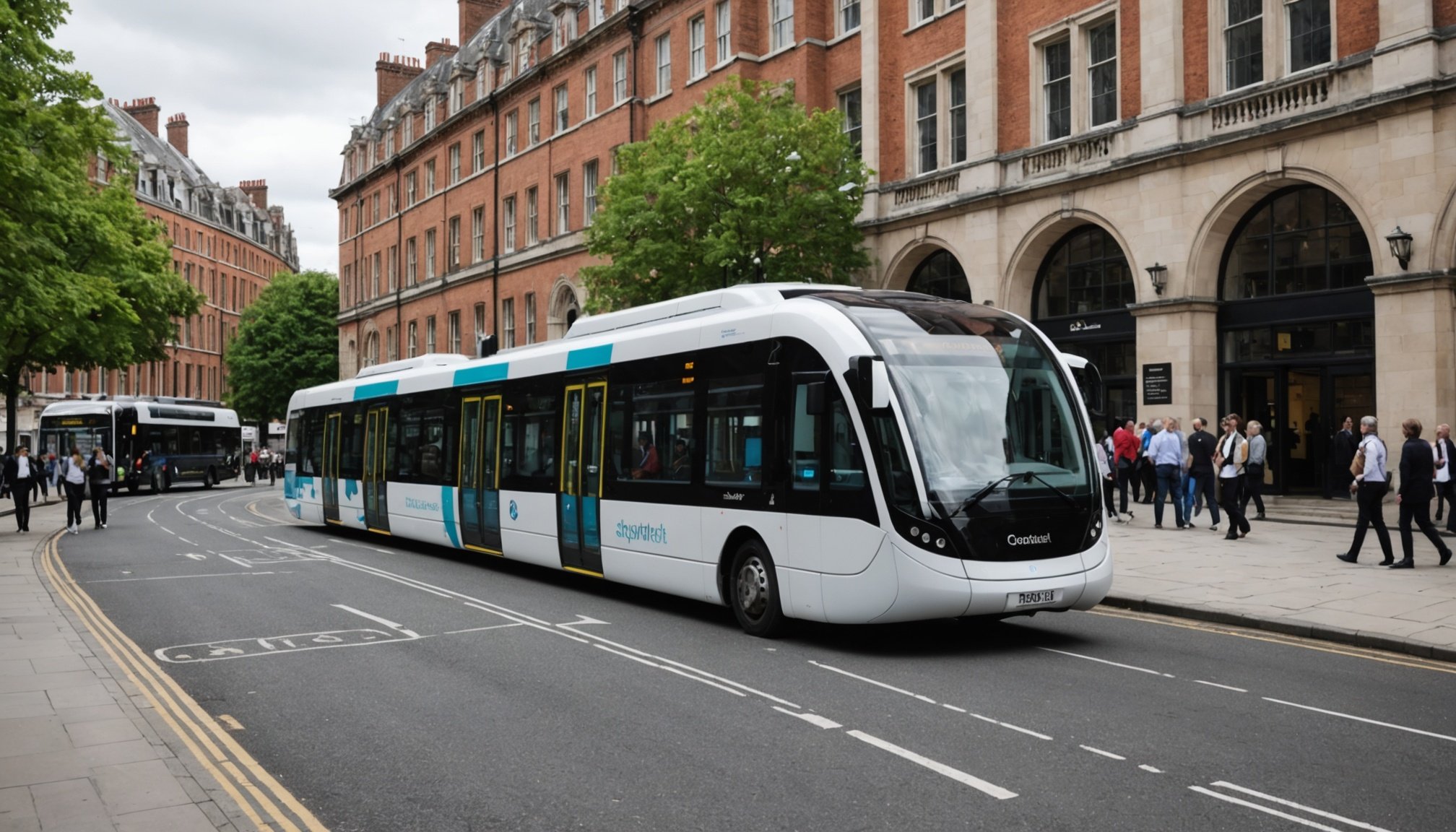Current Trends in Self-Driving Public Transportation
In recent years, self-driving technology has evolved from a futuristic concept to a tangible reality altering the landscape of public transport trends globally. Around the world, cities are exploring autonomous vehicles as a viable urban mobility solution to enhance efficiency and safety in transportation networks. This shift is significant, as autonomous vehicles have the potential to transform how cities address congestion and emissions by integrating seamless and sustainable travel options.
In the UK, transportation innovations have embraced self-driving technologies in several public transport projects. UK cities are experimenting with autonomous shuttles, aiming to balance demand and operational costs while ensuring passenger safety. These initiatives reflect a growing interest and investment in reshaping transportation systems to suit modern needs. Such adoption is crucial for setting a precedent for other regions contemplating similar technological transformations.
In the same genre : Discover the best poker rooms for thrilling online play
The impact of self-driving technology on urban mobility solutions is profound, with promises of reduced traffic congestion and improved travel times. This paradigm shift also necessitates a robust framework to address challenges related to infrastructure, regulation, and public acceptance. The excitement surrounding these developments indicates an embrace of innovation, with the potential to redefine how public transport operates in urban environments.
Benefits of Self-Driving Public Transportation
Self-driving public transportation offers several advantages of autonomous transport that are transforming how we commute. One of the most significant benefits is the enhancements in accessibility for various demographics. Autonomous vehicles can provide dependable mobility options for the elderly, those with disabilities, and individuals without driver’s licenses, thereby broadening access to public transportation services.
In the same genre : Iranian resistance: unfolding the future of freedom in iran
Furthermore, these innovative systems significantly boost public transport efficiency. Self-driving vehicles can operate with heightened precision, reducing wait times and optimizing routes based on real-time data. This efficiency translates into increased operational efficiency and reduction of costs for transport authorities. Maintenance and staffing expenses may also decrease, potentially resulting in more budget availability for expanding services.
Environmental advantages are another key aspect. By minimizing human error, autonomous taxis and buses ensure optimal driving practices, contributing to the reduction of emissions. Electric autonomous fleets can especially decrease the carbon footprint, aligning with global sustainability goals.
Adopting autonomous transport reflects a forward-thinking approach that prioritizes an inclusive, efficient, and eco-friendly future for public transportation systems worldwide. With these technologies, societies can take substantial strides toward reducing traffic congestion and enhancing commuter experiences.
Challenges Facing Self-Driving Public Transport
The realm of autonomous transport challenges is vast and complex. One primary issue is the intersection of technological limitations and road infrastructure readiness. Self-driving vehicles rely on high-resolution maps, sensors, and connectivity, yet many urban areas lack the required infrastructure. This technological gap hinders the smooth operation of autonomous systems.
Moreover, safety concerns continue to dominate discussions around self-driving public transport. While these vehicles promise increased safety by reducing human error, incidents involving autonomous vehicles have cast doubts on their reliability. Public perceptions remain sceptical, with many questioning whether the technology is mature enough to replace human drivers entirely.
Regulatory issues further complicate the landscape. The legal framework governing self-driving vehicles is still in its infancy, leading to confusion and inconsistencies in how different jurisdictions handle autonomous transport. Striking a balance between encouraging innovation and ensuring public safety is a critical regulatory hurdle.
Addressing these challenges requires collaborative efforts from technology developers, urban planners, and policymakers. Only by aligning technological advancements with comprehensive regulations and infrastructure improvements can self-driving public transport transition from concept to reality.
Case Studies of Self-Driving Initiatives in the UK
Exploring self-driving initiatives offers valuable insights into the future of public transportation. Across the UK, several pilot projects have set the stage. In Milton Keynes, a successful trial saw autonomous pods ferrying passengers on designated routes, showcasing smooth navigation through urban areas. Similarly, Greenwich hosted the GATEway Project, marking a milestone in understanding autonomous vehicle interaction with pedestrians within complex city environments.
User feedback plays a critical role in shaping these initiatives. Trials have reported that users appreciate the convenience offered by such technology, but also voice concerns about safety and technical reliability. Addressing these concerns will be essential in its widespread adoption.
Lessons from these UK case studies highlight the importance of regulatory frameworks, infrastructure adjustments, and thorough public engagement. As such, future developments can learn from existing trials by concentrating on:
- Enhancing safety features on self-driving vehicles.
- Promoting technology awareness among locals.
- Ensuring technology fits seamlessly into existing transport networks.
The information gathered from these sessions not only informs stakeholders and developers but also paves the way for successful implementations in broader public transport scenarios. Ultimately, these pilot projects serve as a testing ground for large-scale rollouts, providing lessons for global autonomous transportation endeavors.
Expert Insights and Industry Perspectives
Delving into the realm of transportation technology insights reveals a fascinating array of expert analysis on self-driving transport. To paint a vivid picture, we tapped into conversations with industry leaders and transportation experts. Their opinions shed light on the pivotal transformations underway. One leading voice predicts a radical shift towards automated vehicles shaping urban landscapes within the next decade. With significant advancements in artificial intelligence, industry opinions lean towards increased safety and efficiency as key benefits.
Strategic recommendations emerge from these discussions, urging stakeholders and policymakers to adopt a proactive approach. Experts suggest a balanced regulatory framework to support innovation while ensuring public safety. Moreover, collaboration between governments, technology companies, and academic institutions is deemed essential to navigate the complexities of autonomous mobility.
Additionally, these insights emphasize the importance of public perception and trust. To foster this, transparency in development and rigorous testing protocols are recommended. As these technologies evolve, industry leaders envisage a future where self-driving transport not only revolutionizes commuting but also contributes to addressing environmental and congestion challenges. To capitalize on this transformation, a concerted effort to prepare infrastructure and societal acceptance is necessary.
Regulatory Considerations for Autonomous Public Transport
The development and deployment of self-driving vehicles in public transport is not without its challenges, particularly when it comes to regulatory considerations. In the UK, current regulations for autonomous vehicles are primarily guided by the government’s initiative to ensure safety and reliability in this emerging sector. The legal framework is evolving, aiming to balance innovation with public trust.
To understand the impact of government policies, one must examine the proposed regulations. Current proposals seek to address key issues such as liability in case of accidents, data privacy concerns, and the establishment of minimum safety standards.
A collaborative effort between government bodies and industry stakeholders is paramount in shaping these regulations. Such cooperation ensures that regulations are not only comprehensive but also adaptive to technological advancements.
Moreover, ongoing assessment and revision of these policies are crucial as the technology develops. This proactive approach will help accommodate advancements in self-driving technology while safeguarding public interests.
Thus, the collaboration between the government and industry can lead to robust frameworks that facilitate the widespread adoption of autonomous public transport. These frameworks are essential to encourage innovation while maintaining essential safety and legal standards.
Comparison Between Self-Driving and Traditional Transport Systems
The key differences between traditional and self-driving public transport systems primarily revolve around the presence of human drivers and the extent of computer automation involved. Traditional transport requires a human driver to manually operate the vehicle, while autonomous systems utilize advanced algorithms and sensor technologies to function without human intervention.
In terms of efficiency metrics, autonomous systems often excel through precise route management, reduced human error, and optimised fuel consumption. These systems can potentially reduce traffic congestion and improve time management by communicating with other vehicles and infrastructure in real-time, something traditional systems lack.
An important aspect is public acceptance and how users experience each system. While traditional transport is a well-understood and trusted entity, many people have reservations about the safety and reliability of autonomous vehicles. User experience for traditional transport can be influenced by factors like driver behaviour, whereas in self-driving systems, the focus shifts to the comfort and reliability of automation.
Thus, by leveraging efficiency metrics, autonomous systems hold potential for improved urban traffic systems if public acceptance can be sufficiently cultivated and barriers to acceptance addressed effectively.











